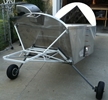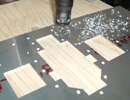


random user submitted photo
Any tips on positioning flap ribs inside drilled skins...
4 posts
• Page 1 of 1
Any tips on positioning flap ribs inside drilled skins...
Trying to get back to working regular hours on my Waiex project after four months of higher-than-normal workload and before I even step foot in the shop I know I'll get stalled by the same issue I wrangled with before work overwhelmed my schedule: How best to position the marked flap ribs inside the drilled skins. The two ribs deepest in the flaps are too far for me to reach; failed in my attempts to use something to nudge the two deepest ribs into line with the holes in the skin. Any and all tips welcome and needed. And for the record, these are standard flaps, not the shorter ones you make to go with the acro ailerons.
Thanks to any who offer tips...
Thanks to any who offer tips...
Dave Waiex #0216
- airscribe
- Posts: 18
- Joined: Fri Dec 04, 2015 2:29 pm
- Location: Wichita, KS
Re: Any tips on positioning flap ribs inside drilled skins..
Hi Dave, I don't have any bad memories of this so it must have been pretty easy. Don't forget that you can spring back the skin to get some access. I'm pretty sure that I just lined up the forward flange centre line of the rib with the skin pilot holes, not worrying too much about the rest of the holes. Drilled and clecoed a couple of holes to locate the forward edge, then lined up the rib at the trailing edge. You can do minor adjustments with a stick poked in from the end.
Peter
Peter
- peter anson
- Posts: 558
- Joined: Thu Jul 31, 2014 2:34 am
- Location: Mount Macedon, Australia
Re: Any tips on positioning flap ribs inside drilled skins..
I did exactly what Peter suggested. Let me try to break it down in a bit more step-by-step detail, in the hopes that it will ease your frustration:
Hope this guide helps you in your build!
--Noel
Sonex #1339
- Use a sharpie to mark the centerline of the rib flanges (this is where the rivet holes should be drilled through)
- Use a sharpie to measure and mark the rivet hole locations on the flap skin
- For each flap rib, look at the front face of the flap (where the skin overlaps itself)
- On the larger part of this front face (where there is no overlap), drill 2-3 of the rivet holes with your pilot bit (#40) but skip the one where the skins overlap (you will wind up drilling holes later through your hinge material).
- Pilot-drill the top & bottom flap skin holes - be careful not to punch through so hard that you drill into the skin on the opposite side. Putting a piece of wood inside the skin to "back up" your drill is a good idea. (See the steps below for how to get inside the skin)
- Gently lift up on the overlapping skin to "peel open" the flap skin. Don't bend it too hard or too far or you may crease the skin, but you should be able to pull it open plenty wide-enough to slip the flap rib into position.
- You might want to use some small wood blocks to hold the skin open by a few inches. This will let you use small clamps to hold the flap rib forward against the face where you drilled the pilot holes.
- Line up the flap rib so that your centerline mark is visible in the pilot holes on the front face of the flap skin.
- Clamp in place, and drill through these holes in the front face, cleco'ing as you go.
- Now your flap rib is pretty securely held in-place at the front face. You can use a broom-handle or other long tool to push or pull on the trailing edge of the flap rib to get the centerline marker to show through in the pilot-holes you drilled in the top & bottom flap skin.
- Working from front to back, nudge the rib into position, then you can "pin" it in place by gently pressing with your fingers about 1" on either side of the flap rib ("trapping" the rib flange in the middle with downward pressure on the skin). Pilot-drill the hole and cleco it in place.
- As you work towards the trailing edge, the rib should naturally start to line up better and better (although with a shorter bending length it will also get stiffer - so its important to be pretty accurate with the first few holes, to set yourself up for an easier time later on.
Hope this guide helps you in your build!
--Noel
Sonex #1339
- NWade
- Posts: 527
- Joined: Mon Aug 08, 2011 3:58 pm
Re: Any tips on positioning flap ribs inside drilled skins..
Thanks, Peter, Noel and Robbie...all your tips make sense and hope to put them to use in a couple of days...
Dave
Dave
Dave Waiex #0216
- airscribe
- Posts: 18
- Joined: Fri Dec 04, 2015 2:29 pm
- Location: Wichita, KS
4 posts
• Page 1 of 1
Who is online
Users browsing this forum: No registered users and 18 guests







